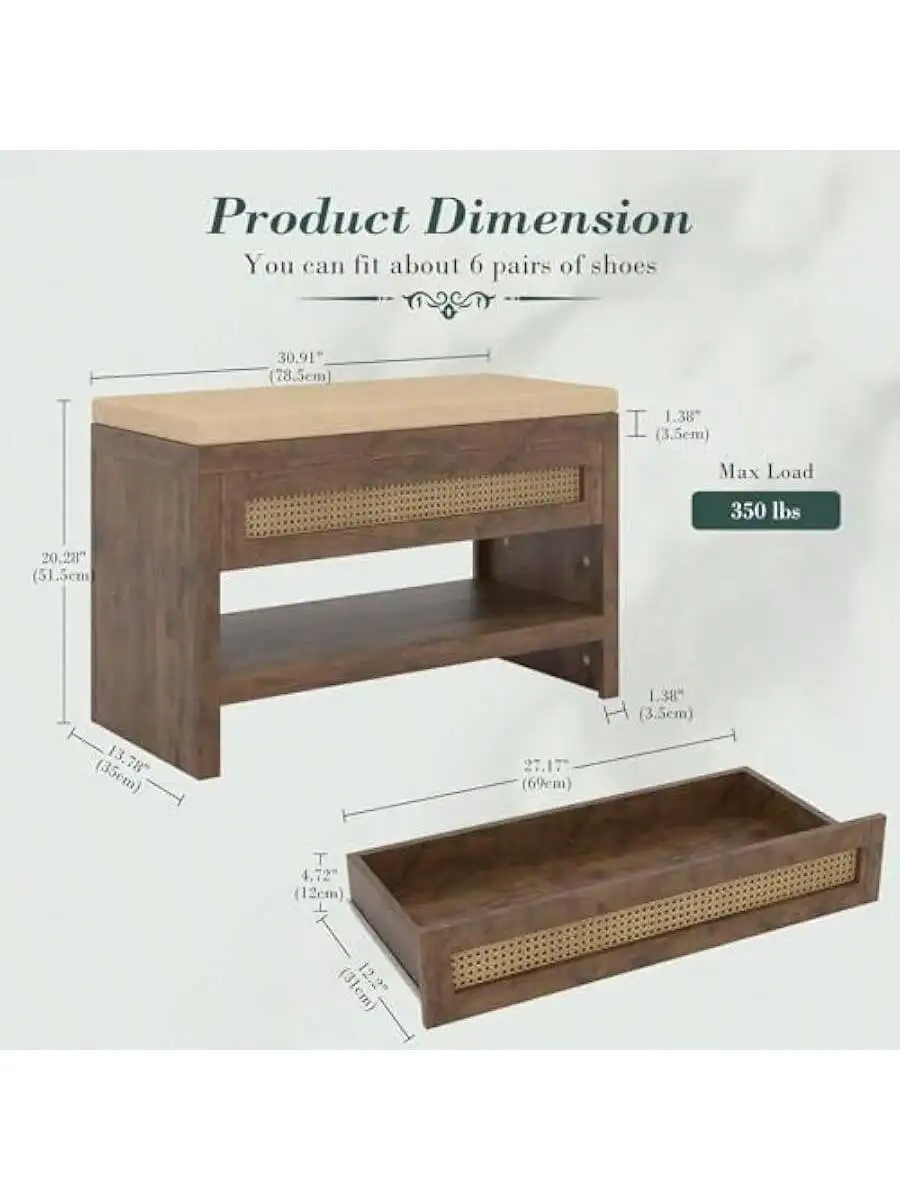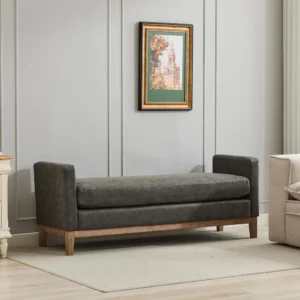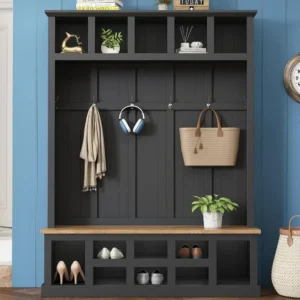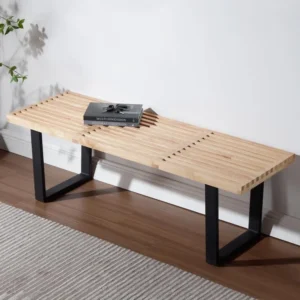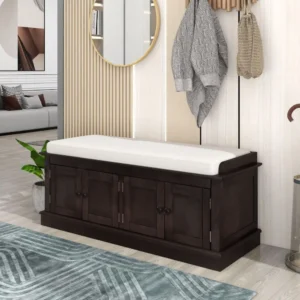Introduction: Transform Your Entryway with Smart Storage Solutions
The entryway of your home often becomes a collection point for everyday items—shoes scattered across the floor, coats hanging on doorknobs, backpacks and bags creating obstacles to navigate around. This daily clutter not only creates visual chaos but also starts and ends your day with unnecessary stress and inefficiency.
Multi-functional mudroom benches offer an elegant solution to this common household challenge. These versatile pieces combine comfortable seating with thoughtful storage options, transforming your entryway from a cluttered catch-all into an organized, functional space. Rather than separate furniture pieces taking up valuable floor space, these benches integrate multiple needs into one smartly designed unit.
What makes these benches truly essential is their dual nature as both practical organizers and attractive furnishings. Beyond simply hiding clutter, they enhance your home’s first impression while creating a dedicated space for daily transitions—a place to sit while removing muddy boots, a spot to store seasonal accessories, and a structured system for organizing everything from sports equipment to school supplies. The best functional mudroom seating solutions seamlessly blend into your home’s aesthetic while solving real organizational challenges.
Understanding what a mudroom bench truly offers reveals why these pieces have become essential elements in well-designed homes—they’re not just furniture, but solutions to the everyday chaos of coming and going.
The Essential Benefits of Multi-Functional Mudroom Benches
Space Optimization
Multi-functional mudroom benches excel at maximizing limited entryway square footage. Unlike separate storage units, hooks, and seating that consume valuable floor space, these benches combine multiple functions into a single footprint.
- Consolidates seating, storage, and organization into one piece of furniture
- Utilizes vertical space with hooks and shelving above the bench
- Typical bench footprint of 42 inches (107 cm) wide by 18 inches (46 cm) deep can store up to 8 pairs of shoes
- Reduces the need for multiple furniture pieces in high-traffic areas
Organization Solutions
Beyond simply providing storage, these benches create systems that encourage consistent organization habits.
- Designated spaces for specific items prevent “floating” clutter
- Compartmentalized storage helps separate items by family member or purpose
- Hidden storage conceals unsightly items while keeping them accessible
- Seasonal flexibility allows reconfiguration for different weather needs
Convenience Factors
The practical advantages of a strategically placed mudroom bench significantly improve daily routines.
- Provides comfortable seating for putting on and removing footwear
- Creates a transitional space between outdoors and indoors
- Reduces morning scrambles with everything organized and accessible
- Prevents dirty or wet items from being carried throughout the home
Aesthetic Improvement
Well-designed mudroom benches don’t just organize—they elevate the appearance of your entryway.
- Creates a cohesive, intentional look rather than scattered storage solutions
- Available in styles that complement any home décor from farmhouse to contemporary
- Transforms utilitarian storage into an attractive design feature
- Establishes a welcoming first impression for guests entering your home
The wide variety of mudroom benches available today means homeowners can find options perfectly suited to their specific space constraints and organizational needs.
Exploring Different Types of Multi-Functional Mudroom Benches
Understanding the different mudroom bench configurations helps you choose the perfect solution for your specific entryway challenges. Each design offers unique advantages depending on your space, storage needs, and household habits. Mastering mudroom bench styles starts with knowing the key categories available.
Storage-Integrated Bench Designs
Storage-integrated benches represent the foundation of multi-functional mudroom furniture, with each storage configuration offering distinct organizational benefits.
- Open cubby designs provide excellent visibility and air circulation, ideal for frequently used shoes that benefit from drying out between uses. Standard cubby dimensions of 12×12 inches (30×30 cm) accommodate most footwear and accessories.
- Drawer systems conceal clutter while allowing for organized categorization of smaller items like gloves, scarves, and pet supplies. These prevent visual overwhelm and maintain a cleaner aesthetic.
- Lift-top/flip-top storage maximizes interior volume with a hinged seat that opens to reveal a large compartment. This design is perfect for storing bulkier seasonal items like winter boots or sports equipment.
The right entryway bench storage configuration depends on your specific items and whether you prefer visible accessibility or a more concealed approach to organization.
Hall Tree Bench Combinations
Hall tree bench combinations offer the most comprehensive entryway solution by integrating horizontal and vertical storage.
- All-in-one design combines seating, shoe storage, upper shelving, and 4-8 coat hooks
- Standard dimensions of 60-72 inches (152-183 cm) tall provide significant vertical organization
- Mirrored options add functionality while making spaces appear larger
- Divided sections create personalized “stations” for different family members
These hall trees and coat rack benches are ideal for family households where multiple people need designated organization areas, effectively eliminating the “where’s my backpack?” morning scramble.
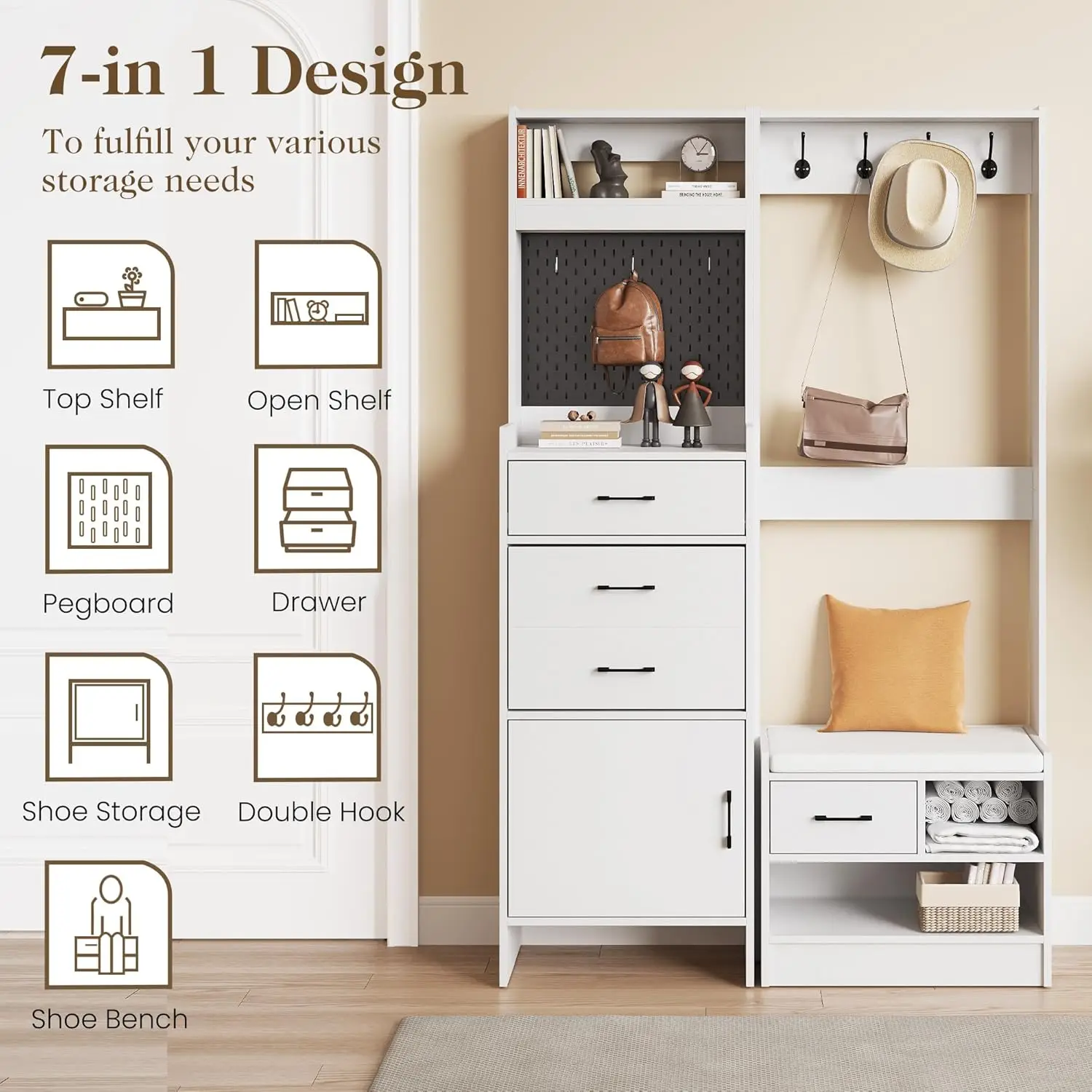
Modular and Customizable Bench Systems
Modular bench systems provide flexibility through components that can be arranged and expanded based on changing needs.
- Mix-and-match elements allow customized configurations for unusual spaces
- Expandable designs grow with your family or adapt to different homes
- Interchangeable components let you add or remove features as needed
- Consistent design language ensures cohesiveness even when adding pieces
For growing families or those who anticipate changing storage needs, mudroom bench cubbies in modular systems offer adaptability that fixed furniture cannot match.
Wall-Mounted and Floating Bench Solutions
Wall-mounted benches create organization in even the most compact entryways by eliminating floor-consuming legs.
- Creates the illusion of more floor space in tight quarters
- Typically supports 250-400 pounds (113-181 kg) when properly installed
- Simplifies cleaning underneath with complete floor access
- Offers a contemporary, minimalist aesthetic
These narrow entryway benches are particularly valuable in apartments, condos, and smaller homes where every square inch matters.
Critical Features to Consider When Selecting Your Ideal Bench
Finding the perfect mudroom bench requires balancing practical considerations with aesthetic preferences. The following features determine not only how your bench looks, but how effectively it functions for your household’s specific needs. Mudroom seating for busy homes requires thoughtful evaluation of these key factors.
Storage Capacity and Configuration
The right storage configuration transforms a simple bench into a hardworking organizational system.
- Match storage types to specific items—open cubbies for frequently accessed shoes, drawers for smaller accessories, cabinets for cleaning supplies
- Consider quantity needs—average households require storage for 2-4 pairs of shoes per person
- Evaluate specialized storage features like boot trays, umbrella stands, or mail slots based on your climate and habits
- Balance visible versus concealed storage based on your organizational style and aesthetic preferences
For households with extensive footwear collections, mudroom benches with shoe storage provide dedicated spaces that prevent shoes from migrating throughout the home.
Dimensions and Space Planning
Proper dimensions ensure your bench fits both your space and your body comfortably.
- Seat height: 17-20 inches (43-51 cm) provides ergonomic seating for most adults
- Seat depth: 14-18 inches (36-46 cm) balances comfortable seating with space efficiency
- Overall width: Ensure at least 12-18 inches (30-46 cm) of seating width per person
- Clearance space: Maintain at least 36 inches (91 cm) of walkway space in front of the bench
Always measure your available space before purchasing, accounting for door swings, baseboards, and traffic patterns that might impact placement.
Materials and Durability Factors
Materials significantly impact both appearance and longevity, especially in high-traffic entryways exposed to moisture and dirt.
| Material Type | Durability | Maintenance | Best For |
|---|---|---|---|
| Solid hardwood (oak, maple) | High (8-10/10) | Moderate | Long-term investment, traditional homes |
| Engineered wood/MDF | Medium (5-7/10) | Easy | Budget-conscious buyers, contemporary styles |
| Metal frames | High (9/10) | Easy | Industrial styles, high-traffic areas |
| Upholstered elements | Low-Medium (3-6/10) | Moderate-High | Comfort priority, lower-traffic areas |
Wooden mudroom benches offer timeless appeal and excellent durability when properly sealed against moisture, making them popular choices for long-term investments.
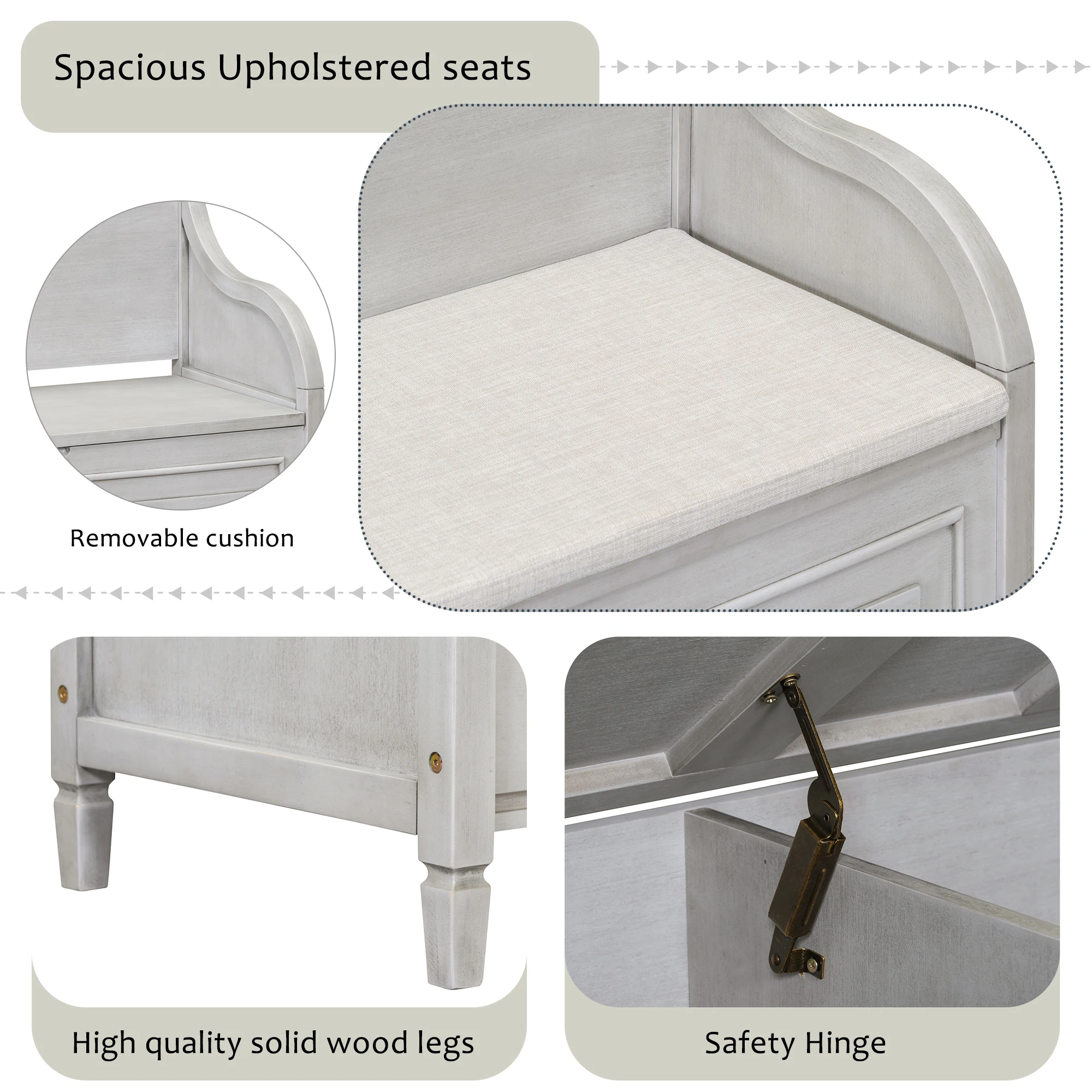
Design Styles and Aesthetic Considerations
Your mudroom bench sets the tone for your home’s entrance and should complement your overall interior design.
- Farmhouse/rustic styles feature distressed woods, simple lines, and matte metal accents
- Modern designs emphasize clean lines, mixed materials, and minimal ornamentation
- Traditional benches incorporate curved elements, richer woods, and detailed craftsmanship
- Transitional pieces blend elements from multiple styles for versatile placement
The complete guide to designing functional mudrooms can help align your bench selection with your broader design vision.
Additional Practical Features
Premium features elevate ordinary benches into exceptional organizational solutions.
- Integrated charging stations keep devices powered while creating a dedicated “drop zone”
- Soft-close mechanisms prevent slamming drawers and extend furniture life
- Weather-resistant treatments protect against wet boots and outdoor elements
- Cushioned seating enhances comfort for longer sitting periods
For added comfort during longer sitting periods, mudroom benches with cushions provide a softer surface while adding a decorative element through fabric choices.
Design Ideas for Maximizing Your Mudroom Bench
Thoughtful placement and complementary elements transform a basic bench into a comprehensive organization system. Consider these design strategies to maximize functionality in different spaces. Learning to transform spaces with multi-use corner benches can provide inspiration for even the most challenging layouts.
Smart Solutions for Small Entryways
Limited space requires strategic thinking to achieve maximum organization without overwhelming the area.
- Opt for narrow benches under 30 inches (76 cm) wide with vertical storage components
- Utilize corner placements to activate otherwise unused spaces
- Choose reflective or light-colored materials to enhance spatial perception
- Implement wall-mounted designs that create floor clearance for visual expansion
Small spaces benefit from mudroom benches with special features for tight areas that emphasize vertical storage while minimizing footprint.
Vertical Storage Enhancement Strategies
Expanding upward multiplies storage capacity without increasing floor space requirements.
- Install floating shelves above benches for displaying decorative items while storing essentials
- Add hook systems at different heights to accommodate both adults and children
- Consider pegboard backings for customizable, adjustable organization
- Implement cabinet systems above benches for concealed storage of seasonal or rarely-used items
Vertical integration transforms a simple bench into a complete entryway system that captures clutter before it enters the home.
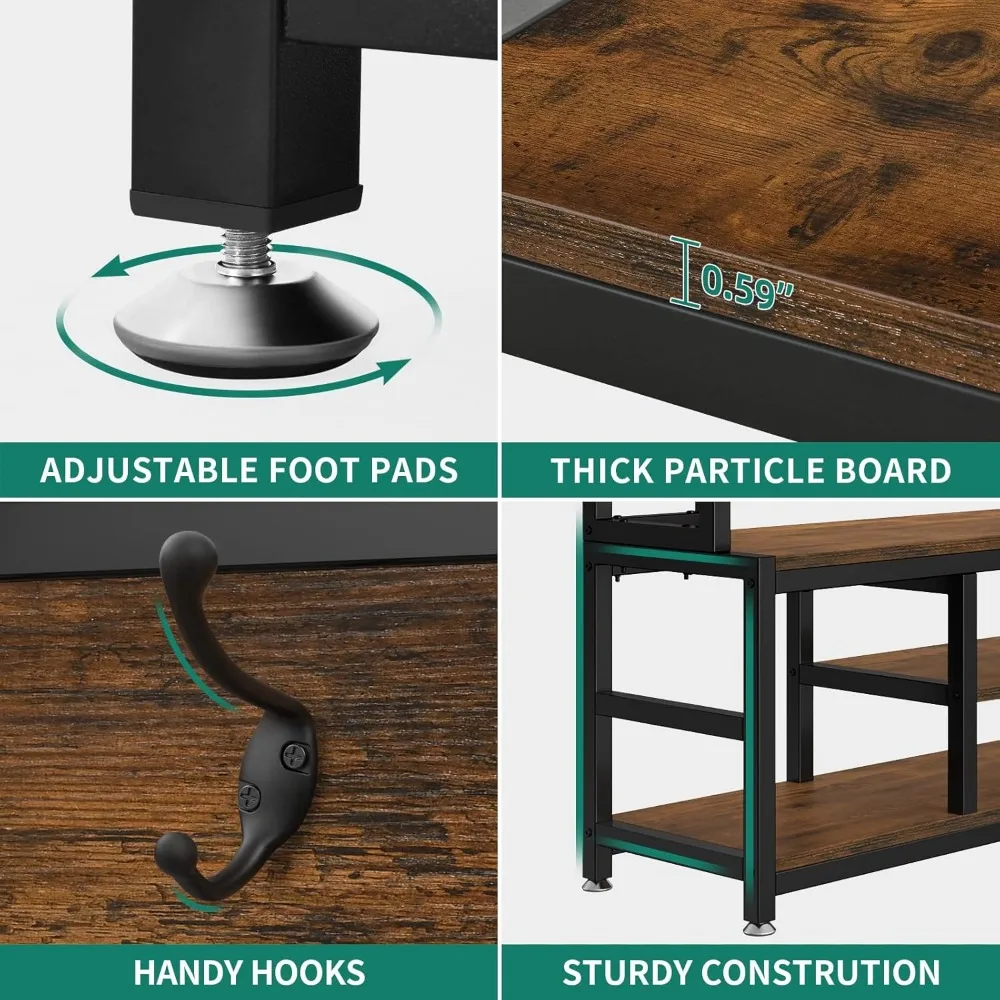
Built-in vs. Freestanding: Making the Right Choice
Your home’s architecture and your long-term plans should guide this fundamental decision.
| Consideration | Built-In Advantages | Freestanding Advantages |
|---|---|---|
| Permanence | Custom-fit to space | Relocatable for flexibility |
| Installation | Requires carpentry skills | Simple assembly, no renovation |
| Cost | Higher initial investment | More affordable entry point |
| Customization | Tailored to exact specifications | Limited to available designs |
| Home Value | Potential to increase property value | Can move with you to new home |
Built-in options create seamless integration with existing architecture, while freestanding pieces offer flexibility for changing needs or future moves.
Your Complete Buying Guide: Finding the Perfect Bench
Selecting the ideal mudroom bench requires balancing practical considerations with aesthetic preferences and budget constraints. This systematic approach will help narrow down options to find your perfect match.
Assessing Your Household’s Specific Needs
Before browsing options, evaluate your specific requirements with these key questions:
- How many people will regularly use the bench?
- What specific items need storage in your entryway?
- What are the exact dimensions of your available space?
- Do you need specialized storage for particular items (sports equipment, pet supplies)?
- What weather conditions impact your entryway needs (snow boots, umbrellas, wet gear)?
- Are children, elderly family members, or pets part of your household?
Creating an inventory of items that currently create clutter in your entryway provides a concrete guide for necessary storage capacity.
Understanding Value Across Price Points
Mudroom benches represent different investments depending on materials, construction quality, and features.
| Price Tier | Typical Features | Best For | Expected Lifespan |
|---|---|---|---|
| Entry-level ($100-300) | Basic storage, engineered woods, simple designs | Temporary solutions, rentals, light use | 3-5 years |
| Mid-range ($300-600) | Better materials, more storage options, enhanced stability | Family homes, daily use, design-conscious buyers | 5-10 years |
| Premium ($600+) | Solid hardwoods, custom features, superior craftsmanship | Forever homes, design statements, heirloom quality | 10-20+ years |
Understanding mud bench costs helps set realistic expectations for quality and durability at different price points.
Where and How to Purchase Your Bench
Finding the right purchasing channel affects both selection range and buying experience.
- Online retailers offer the widest selection but without tactile evaluation
- Furniture stores allow testing of comfort and quality but with limited inventory
- Custom woodworkers provide personalized designs but at premium prices
- Second-hand marketplaces offer potential value but require patience
When evaluating product descriptions, look beyond marketing language to specifics like weight capacity, material composition, and exact dimensions including interior storage measurements.
Entryway Bench with Cushion, Mudroom Bench with Cushion, Shoe Bench for Entryway
$1,186.63 Select options This product has multiple variants. The options may be chosen on the product pageCoat Rack Shoe Bench, Corner Entryway Bench, Corner Hall Tree, Shoe Bench for Entryway
$313.58 Select options This product has multiple variants. The options may be chosen on the product pageBench with Hooks and Storage, Entryway Hall Tree, Mudroom Bench with Cubbies, Mudroom Bench with Shoe Storage
$818.38 Select options This product has multiple variants. The options may be chosen on the product pageModern Entryway Bench, Wood Entryway Bench, Wood Mudroom Bench
$497.69 Select options This product has multiple variants. The options may be chosen on the product pageEntryway Coat Rack Bench, Entryway Hall Tree, Farmhouse Mudroom Bench, Mudroom Bench with Shoe Storage
$805.09 Select options This product has multiple variants. The options may be chosen on the product pageEntryway Bench with Cushion, Mudroom Bench with Cabinets, Shoe Bench for Entryway, Shoe Bench with Cushion
$991.71 Select options This product has multiple variants. The options may be chosen on the product page
Maintaining Your Mudroom Bench for Years of Use
Proper maintenance extends the life of your mudroom bench while preserving its appearance and functionality. Because entryways experience significant traffic and exposure to outdoor elements, regular care prevents premature deterioration.
For wooden benches, quarterly application of furniture polish or wood conditioner prevents drying and cracking, especially in dry winter months when indoor heating reduces humidity. Wipe spills immediately to prevent water marks, and use coasters under wet boots or umbrellas to protect finished surfaces.
Metal components benefit from occasional inspection for rust spots, particularly near hinges or in areas where boots might introduce moisture. For upholstered elements, fabric protector spray provides a defensive barrier against stains, while removable cushion covers allow for periodic washing to maintain freshness.
- Wood maintenance: Dust weekly, polish quarterly, immediately clean spills
- Metal components: Check for rust quarterly, apply touch-up paint as needed
- Fabric elements: Vacuum regularly, spot-clean promptly, apply stain protection
- Moving parts: Lubricate hinges and drawer slides annually
- Seasonal care: Deep clean in spring and fall, rotating seasonal items
Frequently Asked Questions About Mudroom Benches
What is the Standard Size for a Comfortable Mudroom Bench?
Most comfortable mudroom benches range from 17-20 inches (43-51 cm) in height and 14-18 inches (36-46 cm) in depth. Width varies based on available space, but allowing 18-24 inches (46-61 cm) of width per person provides comfortable seating. For families, benches of 42-60 inches (107-152 cm) wide accommodate multiple users while fitting standard wall spaces.
Can Any Mudroom Bench Accommodate Cushions?
Most flat-surface mudroom benches can accommodate cushions, though some designs work better than others. Look for benches with slight recesses or lips around the seating area to prevent cushion sliding. Standard cushion dimensions range from 1-3 inches (2.5-7.6 cm) thick and should match your bench width while extending to about 2 inches (5 cm) from the front edge for comfort without overhang.
How Can I Maximize Storage in an Extremely Small Entryway?
For extremely compact spaces, consider these space-maximizing strategies:
- Choose corner benches that utilize otherwise wasted angular space
- Select wall-mounted styles under 30 inches (76 cm) wide with no floor footprint
- Prioritize vertical storage with hooks and shelves extending upward
- Look for dual-purpose designs where the seat conceals storage
- Consider fold-down or expandable options that can be compacted when not in use
What’s the Difference Between a Hall Tree and a Mudroom Bench?
Hall trees integrate vertical components (usually 60-72 inches/152-183 cm tall) with coat hooks, shelving, and sometimes mirrors above a bench base. These comprehensive units provide organization from floor to near-ceiling. Standard mudroom benches focus primarily on seating with storage underneath or within the seat itself, typically standing 18-24 inches (46-61 cm) tall. Hall trees offer more complete entryway solutions but require more space and higher ceilings, while basic mudroom benches fit more compact areas but provide less overall storage capacity.

